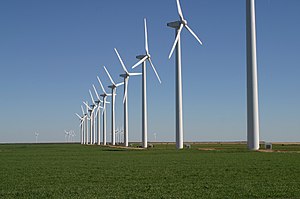Big wind looking for big transmission lines in Austin meeting
 Image via Wikipedia
Image via WikipediaTo get a sense of how contentious Monday's hearing about where to build a massive electric transmission line through the Hill Country will be, consider this: It's being held at the Austin Convention Center.They still have a delivery problem until the transmission line is built. I think it will happen and the and owners are going to have to give up the easements needed for it to happen. They should be trying to get the best deal they can for having to give it up. The story indicates that the wind business has helped to fund West Texas schools by increasing the local rural tax base.
That's big enough to hold more than 1,000 people — and there are easily that many with a stake in the outcome.
At the forefront of the fight are Hill Country landowners opposed to the idea of cutting a football-field-wide swath through more than 130 miles of private ranch land, to erect massive lattice towers for lines that will bring power from West Texas wind to the state's more populous areas.
Also expected is a big pack of lawyers: for the landowners, for wind companies that need the lines, for the cities and counties in favor or opposed, for the Public Utility Commission, which will decide in January where to site the line, for the Lower Colorado River Authority, which has the task of building the line ... the list could go on and on.
The hearing isn't about whether the line should be built, only along what route.
That's because the 2005 state law that directed the lines be built specifically mandated that the question of need be removed from the process.
...
There simply is too much wind power being generated around McCamey that needs to be moved east, the report indicated.
...
The Lone Star State, hardly famous for its environmental activism, now leads the nation in wind power by an exponential degree, with 10,000 megawatts of installed capacity.
There's so much wind energy that existing lines can't carry it all where it needs to go. That congestion raises the price of power, as utilities pay additional fees to get wind delivered.
On the windiest days, congestion is so great that turbines sometimes are forced to shut down.
The roots of Texas' thriving wind industry took hold with the state's decision in 1999 to deregulate its electricity industry. That effort created some odd alliances, many of which persist today.
Environmentalists, who wanted cleaner air and more renewable energy, joined forces with utilities and other business interests that wanted a competitive electric market, in what Tom “Smitty” Smith, director of Public Citizen Texas, called “a grand bargain.”
...
“A lot of people think we have wind because the government is forcing it,” Sloan said. “But we've now got five times the requirement. Extra wind was built because investors saw the potential.”
...
I still believe that it is not a very efficient form of energy and is not all that dependable, but it can supplement more efficient forms of energy.
It is ironic that deregulation and the urge by utilities for greater competition led to the growth of this industry. It must be the kind of deregulation Obama can believe in.
This Washington Post story shows the wrong way to grow this industry. Subsidies just do not motivate like competition does.

Comments
Post a Comment